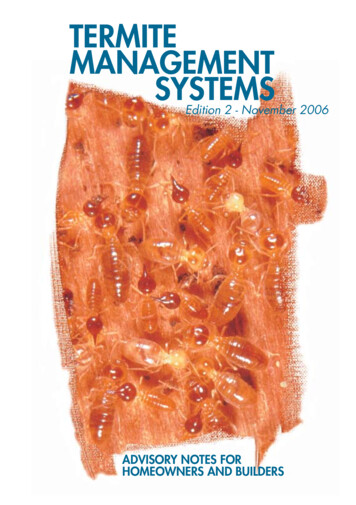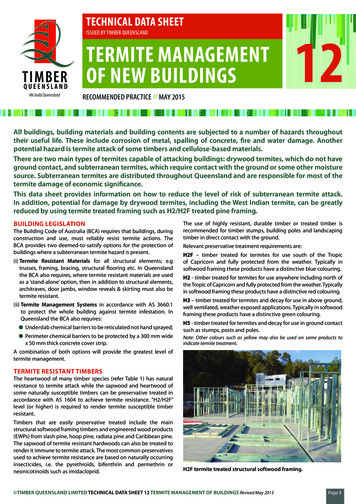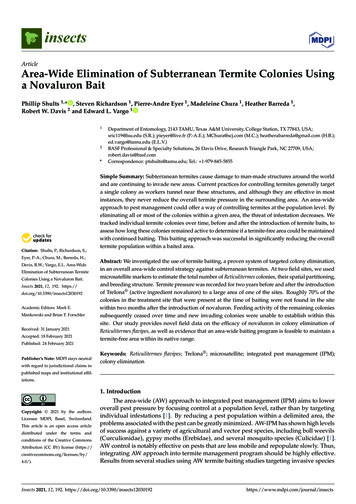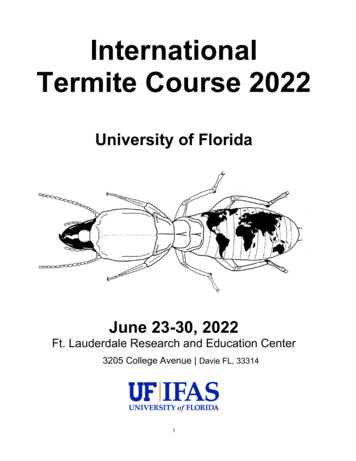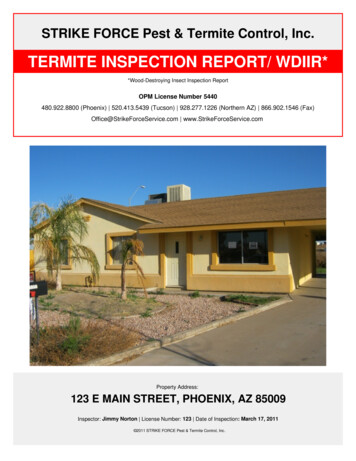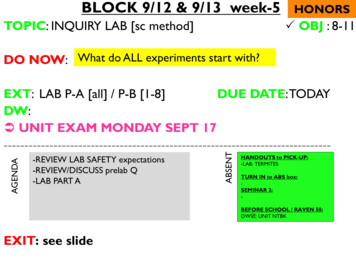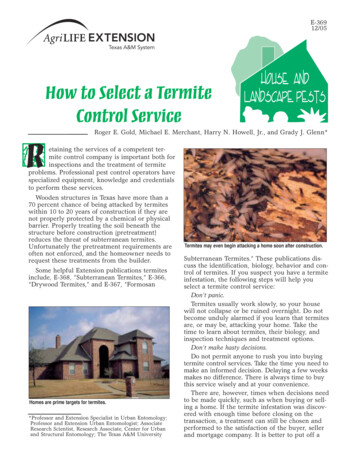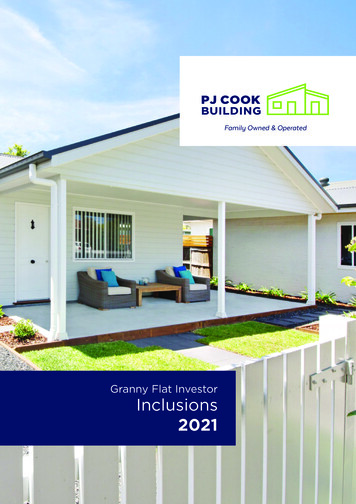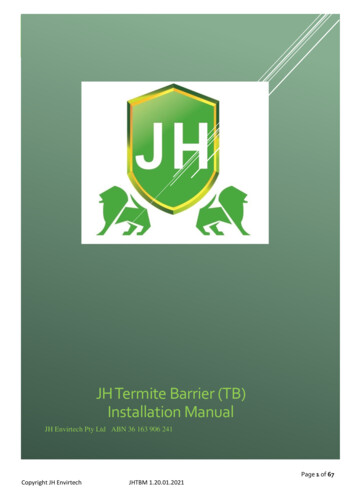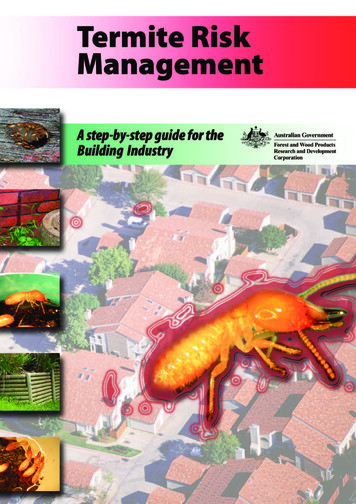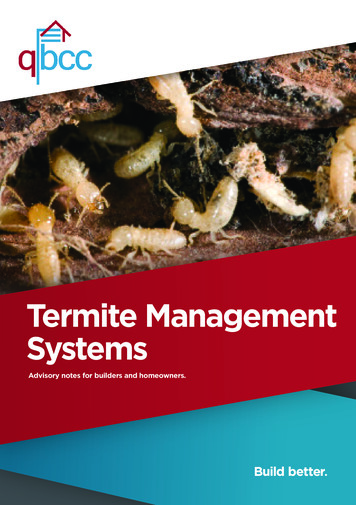
Transcription
Termite ManagementSystemsAdvisory notes for builders and homeowners.
Termite ManagementThe information provided in thispublication relates to Class 1 (houses,townhouses, terrace houses etc) andClass 10A (private garages, carportsetc) buildings as defined in Volume 2 ofthe Building Code of Australia (BCA).qualified operators to carry out regularinspections.Termite infestations cause millionsof dollars in damage each year totimber in homes across Australia.Termites (white ants) are a problem inmost parts of Australia, but they areparticularly active in hot, wet areassuch as Coastal Queensland.For example, installing a water tankagainst a perimeter wall of a dwellingmay breach the visual inspectionbarrier, allow termites to infest thebuilding undetected, and void anywarranty and insurance entitlements.The BCA requires all new homes tohave some form of management todeter subterranean termite attackand there are many different methodsavailable on the market.A home is usually the largestinvestment a person will make intheir life, and the cheapest method oftermite management may not be themost appropriate method for theirspecific site requirements.This publication informs builders, tradecontractors, designers, pest controllersand owners of the facts behind thedifferent types of termite managementsystems, and clarifies responsibilitiesfor on-going maintenancerequirements.A termite management system isintended to minimise the risk of termitedamage to primary elements of abuilding through a concealed route.The installation of a termite barrier willnot stop termite activity from occurringon the site.Owners must be proactive in thedecision making process. And mostimportantly, they must ensure theyarrange for appropriately licensed andOwners must also ensure they do notdisturb or breach termite managementsystems, to maintain their warrantiesand insurance entitlements.
Legal and Licensing Requirementssignificantly different to that of thebuilding. For non-temporary Class 1buildings this means that chemicalscannot be hand-sprayed unless itcan be proven the chemicals willhave at least a 50 year life span.If this cannot be achieved, it maybe necessary for a reticulationsystem to be provided if chemicalsare to be relied upon for termitemanagement below a concrete slabAustralian StandardAustralian Standard 3660.1 - 2014Termite Management - New BuildingWork is referenced in the BuildingCode of Australia (BCA). It is part ofa trilogy of standards including Part 2that deals with existing buildings andPart 3 that deals with assessment fortermite management systems.Licensing For chemical perimeter systems,the requirement is to excavatetrenches, treat the exposed trenchwith chemical, backfill with asuitable material, then treat thebackfill. On completion a 300mmwide x 50mm deep concreteprotection layer (mowing strip)must be installed. The definition of ‘Primary BuildingElement’ is extended to includedoor jambs, window framesand reveals, and architraves andskirting, in addition to structuralmembers. Installation of a durable notice inprominent locations. The performance requirementsalso take into considerationaccessibility for installation,maintenance and inspection oftermite management systems.For example, hand-sprayedchemical perimeter barriers will notbe suitable for zero lot line housing.Termite resistant materials or someother form of termite managementwill need to be considered at thedesign stage.The licences needed for termitemanagement include the licenceclasses Termite Management Chemical and Termite Management- Physical. The latter class is restrictedto particular physical systems such asgraded stone or stainless steel mesh.A contractor must have one of theselicences to provide advice or reportsin relation to termite managementsystems or infestations. A QBCClicence is also required to install termitemanagement systems in new buildingwork.When applying a chemical system, aQBCC licence is required in addition toa Government issued (occupational)Pest Control Operator’s licence.Professional indemnity insurance toa minimum value of 500,000 is alsorequired for licensees holding a TermiteManagement - Chemical licence.Building Code of Australia(Queensland Provisions)The BCA as it applies in Queensland,has a variation that requires: The ability to replenish a chemicaltermite management systemwhere the life of the chemical is
What does building law require?The Building Code of Australiacontains the minimum technicalprovisions of the Queensland BuildingAct 1975 related to the protectionof buildings from damage bysubterranean termites. Any termitemanagement methods that can beshown to meet the BCA performancerequirements with documentedevidence, may be accepted by thebuilding certifier or approval authority.In Queensland, the risk of primarybuilding elements being damagedby subterranean termites must beminimised and provide for a 50 yeardesign life.For houses and associated sheds,carports, garages, etc, clause 3.1.3 ofVolume 2 of the BCA specifies themeans of satisfying the performancerequirements.In the case of termite control,compliance with any of the systems(or a combination of them) detailedin 3660.1 - 2014 satisfies BCA clause3.1.3. 3660.1 - 2014 provides a range oftermite management measures that maybe used, including chemical or physicalbarriers or a combination of any of these.NOTE: Clause 3.1.3 must be read inconjunction with the QueenslandAmendment to the BCA.System solutions for termitesRegular inspectionsMethod of attackRegardless of the system used,regular inspections should becarried out by a QBCC-licensedcontractor with the appropriateTermite Management licence toensure termites have not bridgedthe barrier. It is recommendedthat inspections be at least every12 months, or more often in highrisk areas.Attacks on buildings usually originatefrom a nest below the ground.Termites build mud galleries whenthey are at risk of being exposedto enable them to travel over piersor walls to attack wood and woodproducts in buildings. Usually, thenest is outside the building perimeterbut occasionally a nest may be buriedin the soil beneath the building.Termites can get inside a buildingvia wall cavities, cracks in mortar orconcrete slabs and voids adjacent toservice entry points.Most infestations occur at theperimeter of the building and usuallyresult from owners being unfamiliarwith “good practice”. For example, anexisting termite management systemcan be bridged by building gardenbeds or placing wood chips up to thehouse, or by attaching unprotectedstructures such as carports, pergolasand fences to the house.To expose termite mud gallery intoweephole opening - ensure 75mmminimum clearance to garden bed
1. Chemical SystemsChemical deterrent systems arenormally used in conjunction withslab-on-ground construction.Traditional chemical treatmentsincorporate a chemical reticulationsystem under the slab and around theperimeter of the building.AS 3660.1 - 2014 specifies theprocedures to provide a chemicalsystem that will deter termites fromgaining concealed access to termitesusceptible elements in the building.Section 8 of the Standard does notrefer to any specific chemical. Insteadit allows the use of any chemical thatis registered for the purpose by theAustralian Pesticide and VeterinaryMedicines Authority (APVMA). Thisallows for the introduction of anyfuture approved chemical. (APVMAis a Commonwealth organisationresponsible for the registration of allagricultural and veterinary chemicals).Most chemicals used in termitemanagement have a limited life span.It is recommended you contactthe manufacturers of products forinformation about the life expectancyof these products and details of thelabel conditions that must be adheredto when they are used in termitemanagement systems.Queensland provisions of the BCArequire proof that hand-sprayedchemicals under concrete slabs havea reasonable life span before they canbe used.If, during the regular competentinspection of a building a termiteinfestation is discovered, re-treatmentmay be necessary to remove theproblem and ensure the building isgiven protection to minimise the riskof termite damage.A convenient means of re-treatingunder slabs is through a reticulationsystem. Reticulation systems need tobe installed under the slab prior topouring concrete. A reticulation systemwill allow periodic re-charging fromoutside the building.Owners should educate themselvesbefore making a final decision aboutthe method of control to use. Ask yourbuilder, designer or other competentperson about the proposed termitecontrol method, and on-goingmaintenance responsibilities.CHEMICAL SYSTEMSNOTE: IF THE EXPECTED LIFE OF THE CHEMICALS TOBE USED IS LESS THAN THE EXPECTED LIFE OF THEBUILDING AND THOSE CHEMICALS ARE INACCESSIBLE,A RETICULATION SYSTEM MUST BE INSTALLED TOALLOW FOR REPLENISHMENT OF THOSE CHEMICALS
2. Physical SystemsUntil recently, physical systems havebeen restricted mainly to suspendedfloor construction (e.g. houses builton stumps). The traditional physicalsystem is the ant cap. Ant caps areplaced on the tops of stumps and piersetc. Ant caps do not prevent termitesfrom getting into the building, theymerely act as a barrier to concealedentry and encourage the termites intothe open where they can be noticedduring inspections.METAL FLASHINGThe metal flashing installed in cladframed slab-on-ground constructionshould not be confused with traditionalant capping. A termite managementsystem such as an exposed slab edgeis required in these circumstances.A number of other physical systemsare available that are suited toslab-on-ground construction.In many cases they can also beused in elevated houses.3. Graded StoneGraded stone systems incorporatecarefully graded and shaped, highquality granite particles that can beplaced in a layer under the entireconcrete slab area, around the baseof stumps in an elevated building, asa partial system around the perimeterof the building or around individualpenetrations. Combinations of physicaland chemical systems may sometimesbe necessary.The system works on the principlethat the particles, when placed andcompacted, will not allow the termitesto find a path through them. Theparticles are too hard to eat and aretoo small to allow the movement oftermites between the abutted particles.GRADED STONENOTE: under floor graded stone fill treatment(minimum compacted depth 75mm).Alternatively the underfloor graded stone canbe omitted and the penetrations through theslab protected by an approved system.
4. Stainless Steel MeshStainless steel mesh systemsincorporate finely woven, high-gradestainless steel mesh. This can be usedin the same manner as the traditionalant cap, being placed under theentire concrete slab area, aroundthe perimeter of the building as apartial barrier, or around individualpenetrations. Combinations of physicaland chemical systems may sometimesbe necessary.The manufacturer maintains the gridpattern of the mesh is fine enough tonot allow termites through, and strongenough to prevent them from chewingthrough it.Being stainless steel, it is unlikely tobe affected by the corrosive nature ofsome concrete and ground conditions.Termites can still gain access throughpenetrations that pass through theSTAINLESS STEEL MESHfloor (such as plumbing pipes), and/ orvia the building’s perimeter.These areas require additional controlusing chemical or physical systems.If chemical treatment is used to protectpenetrations in the concrete floor, thewhole of the under-slab area must betreated. If physical systems are used,only the area around the penetrationsneeds to be protected.The BCA requires only the primarybuilding elements of a building to beprotected against damage by termites.The definition of ‘primary buildingelements’ in this instance has beenextended in Queensland to includedoor jambs, window frames andreveals, architraves and skirting.This is in addition to the roof structure,load-bearing walls, beams, floorstructures etc.
5. Concrete slab as termite barriersMost infestations occur at the perimeterof the building. Constructing concreteslabs in accordance with AustralianStandards significantly reducesthe likelihood of major cracking inconcrete slabs, which could permittermite access. The standards includeAS 2870- 2011 Residential Slabs andFootings Construction andAS 3600.1 - 2014 Concrete Structures.edge will not stop termites from gainingaccess into the building, but it willencourage them out into the open wheretermites can be noticed and identified.Baiting can then be applied and the nestdestroyed.CONCRETE SLAB BARRIERThese standards support using theconcrete slab as a termite barrier.This is reflected in AS 3660.1 - 2014.Any of the physical or chemical systemspreviously mentioned can be usedfor termite management treatmentaround a building’s perimeter. Anothercost-effective physical system uses anexposed slab edge. The exposed slabTermite resistant materialsThe BCA allows termite resistant materialsthat protect primary building elements.Termite resistant materials include:Steel: Steel frame systems can consistof steel floor, wall and roof framing.Concrete: A concrete slab-on-groundcan itself form a termite barrier.The slab needs to be constructed inaccordance with AS 2870 - 2011 and AS3600 - 2009.Timber Naturally termite resistant timber inaccordance with Appendix C ofAS 3660.1-2014 Preservative treated timber inaccordance with Appendix D ofAS 3660.1-2014. This can consist ofLight Organic Solvent Preservative(LOSP) to Hazard Level 2 or 3 (H2and H3). Treatments to H4 andH5 levels are required externallywhere timber is in contact with theground. This treatment can also beextended to include window reveals,door jambs, architraves and skirting.Where termite resistant materials areused for primary building elementsas a termite management system inaccordance with the BCA, additionaltermite barriers may not be necessary.Prospective home or building ownersare encouraged to consider ‘whole ofbuilding protection’. There are manyoptions to consider that buildersand owners should discuss. The siteconditions, building design and theowner’s requirements, such as ongoingmaintenance, all need to be consideredbefore signing a contract.
Alternative solutionsThere are several products on themarket that may be accepted byBuilding Certifiers as meeting theperformance requirements of theBCA. The use of alternative solutionsmust be discussed with the BuildingCertifier prior to any works commencing,for example before, but no later than atthe Building Approval stage.Where a project design offers acombination of building systems,such as slab-on-ground and timberframe, and split-level floor systemthat does not suit a particular termitedeterrent method, the owner orbuilder may choose an alternativeor combination of methods that arecost-effective and most suited to thebuilding design.Combination systemsSome system installers may not beprepared to honour their warrantieswhere a combination of systems isused.Split-level and zero-lot-line buildingsare two examples of the need toincorporate physical deterrent systemsor termite-resistant materials.A chemical deterrent system alone maynot be adequate in some cases.Particular attention needs to be givenwhere split level slab-on-groundor composite slab-on-ground andsuspended floor framing are to beincorporated. It is likely that, as in thediagram, a combination of systems willneed to be incorporated.Where a combination of different typesof protection is proposed, ensure thatwarranties apply to the unique systemsbeing used.COMBINATION TERMITE BARRIER SYSTEM
Suspended floorsThe area beneath a suspendedfloor is one of a building’s mostsusceptible areas to termite activity.To be effective, termite managementsystems installed in this area rely totallyon access for both inspection andtreatment if termite activity is detected.To ensure access is always availableto the sub-floor area, an accessdoor or panel must also be provided.AS 3660.1- 2014 contains provisions forsub-floor clearance under suspendedfloors to allow for visual inspections.Where the building has a suspendedfloor, cross flow ventilation must beprovided under the floor. This is todiscourage termite activity and toreduce the likelihood of damage tosub-floor members by fungal attack.Depending on the location of thework, NCC BCA 2016 Vol 2 - Part 3.4.1sets out minimum requirements forventilation per lineal metre of bothinternal and external walls.Ventilation openings must be placedbelow damp-proof courses butabove the level of possible entryof surface water.A minimum clearance of 400mmis generally necessary between thefinished ground level, structuralcomponents and any other obstruction(bearers, floor joists, plumbing pipesetc). The required clearance can bereduced from 400mm to 150mmprovided the area slopes to and is notmore than 2m from a point conformingwith the required 400mm minimumclearance.COMBINATION TERMITE BARRIER SYSTEM
Choosing a systemTermite management systemsshould be based on carefullyselected deterrent methodsand include regular competentinspection. QBCC recommendsusing an acknowledgement noticebefore signing a building contract.The notice confirms that termitemanagement has been discussed indetail between the builder and ownerbefore signing a contract. It detailsthe termite management system tobe incorporated into the works andacknowledges that alternative systemshave been discussed between thebuilder and owner.Building associations and otherorganisations may also provide asimilar document for this purpose.The cost of control methods and theeffective life of the treatment can varyconsiderably, as can ongoing costs andrenewal treatments. While comparingcosts and the effective life-span oftreatments, also compare the warrantybenefits of the different controlmethods before committingInstallation processSubmitting an applicationDuring constructionThe termite control method mustbe detailed on the drawings andspecifications accompanying buildingapplications. Check with your approvingauthority or building certifier todetermine what systems are acceptable.The building certifier (or approvingauthority) may require the licensedinstaller to certify that the systemhas been installed according toAS 3600 - 2009. Where an accreditedproduct has been used, it must beinstalled according to the conditionsspecified in the accreditation certificate.For approved systems that usestainless steel mesh, granite particlesor reticulation systems, the systemmay be acceptable by name. Whereconstruction techniques, such as anexposed slab edge or termite resistantmaterials, are to be used, specific detailsare usually required.Certain construction techniques orpractices such as timber treatments ortimber species need to be documentedby the builder as evidence of buildingcompliance with AS 3660.1 - 2014.
The certificate should contain thefollowing information: Date Owner’s name Builder’s name Property location Real property description Building description Details of termite deterrent workundertaken, including a diagramwhere appropriate Areas (m2) of the procedures fortermite management which maybe due to the building design orowner’s requirements.Site practicesTrade contractors need to take carewhen working in and around buildingswhere there is a risk of compromisingtermite management systems.It is essential to be familiar with thetype of termite management systemused, and its current status. If there isany ambiguity, clarification should besought before undertaking any work.For example, a concreter may need tohave treatment applied or a reticulationsystem installed beneath a concreteslab-on-ground where that slab abutsa building. This can include driveways,carport slabsand footpaths.A landscape contractor installingpaving, concrete pathways or gardensadjacent to and abutting a building willalso need to consider how to managethe termite risk.Plumbers and drainers need to payparticular attention to maintainingthe termite deterrent system wheninstalling pipe work connectionsto buildings.Installing concrete protection blocksover exposed pipe work and atinspection points can provide an easypoint for concealed entry by termites.In the case of chemical perimetersystems, these protection blocks needto be placed in position after thesystem has been installed, being carefulnot to disturb the system.This also applies to electricalcontractors who should be carefulthat electrical conduits do not providean avenue for termite entry, and tocontractors installing any other servicesconnected to a building.Builders must be vigilant in supervisingthe building process to ensure thetermite management system is installedcorrectly and not compromised byother aspects of the building process.This includes the removal of any debrisand mortar slag from footings beforeor as part of site cleaning prior to theinstallation of a chemical system.All form work, set- out pegs and timberprofiles also need to be removed wellclear of the termite managementsystem area.Where construction is of a compositenature, such as where a split levelslab-on-ground forms part of thebuilding or where retaining wallsform part of the structure, specialconsideration is needed to establishan effective termite managementsystem. A chemical system alone maybe inadequate.When using chemical termitemanagement, sandy loam is a suitablesoil type. The use of crusher dust orstone and rubble is not appropriate.Termite management contractorsneed to check that soil conditions aresuitable before applying any chemical.
At building completionWhen the work is finished, the buildershould give the owner informationon the termite management systeminstalled and the owner’s ongoingmaintenance responsibilities. In thecase of chemical systems, it may beappropriate for an owner to enterinto a contract with a QBCC-licensedtermite management contractor forinspection and ongoing treatmentas recommended by the label on theproduct used to form the system.The owner may have to declare to thelocal government that they are awareof the termite control system usedon the building including constraintsand ongoing maintenance provisions.The declaration should be on a formapproved by the local government.The declaration should describe thesystem used and contain details of thecompetent person who gave the adviceon the management system and itsconstraints. Generally, advice from thebuilder and system installer/consultantshould be sought.NoticesThe BCA requires a termite controlnotice to be permanently fixed to thebuilding in a prominent location (suchas the meter box) indicating: The method of protection The date the termite managementsystem was installed Where a chemical system is to beused, its life expectancy as listed onthe APVMA label The installer’s or manufacturer’srecommendations for the scope andfrequency of future inspections fortermite activity.Future building owners should be madeaware of the termite managementsystem used on the building. The onusis on the buyer to make themselvesfamiliar with the on-going maintenancerequirements of the system.Termite management after moving inIt is important for the owner tounderstand that properly installedand maintained termite managementsystems impede and discourageconcealed termite entry intobuildings. They do not always preventunconcealed entry and therefore do notprevent termite attack.Owners should find out what typeof termite management system hasbeen installed in their home. Forexample, they should know what typeof chemical and/or physical systemhas been installed (e.g. concrete slabs,exposed slab edge, metal shielding,stainless steel mesh or graded stone),if termite resistant materials have beenused, or what combination of chemicaland/or physical and/or termite resistantmaterials are in use.Termite management is requiredbelow and around the perimeter of thebuilding. Generally, physical systems willbe designed to last for the lifetime ofthe building with proper maintenance.Chemical systems have a limited life andtherefore require ongoing treatment.
Pre-purchase inspectionsSatisfactory completion of apre-purchase Building Inspection isusually a pre-requisite to the purchaseof a home. A pre-purchase BuildingInspection should be carried out by acontractor appropriately licensed byQBCC and should assess the generalcondition of the property and discoverany major defects in accordance withAS 4349 - 2007 Part 1.In addition to the Building Inspection,a pre-purchase Timber Pest Inspectionis recommended. The Timber PestInspection should also be carried out bya contractor appropriately licensed byQBCC.Part 3 of AS 4349 - 2007 providesminimum requirements for a noninvasive Timber Pest Inspection andreport on timber pest activity within thehouse and for the surrounding propertywithin 30 metres of the building.According to the Standard, the noninvasive pre-purchase Timber PestInspection is a visual inspection thatincludes non-marking sounding ofelements and assessment of themoisture content of materials.The definition of timber pests excludesdry wood termites and mould, butincludes subterraneanand damp wood termites, borersof seasoned timber and wooddecay fungi.The Timber Pest Inspection Reportshould comment on evidence ofpresent or past timber pest activityand associated damage, and anyindications of previous timber pesttreatments. It should also providean assessment of the susceptibilityof the building to attack by timberpests, indicate any conditions thatcould increase the potential for timberpest activity, and where necessary,make recommendations for furtherinvestigation or action.Any Timber Pest Inspection will belimited by the inspector’s competenciesand affected by any impedimentsto the inspectors work at the timeof the inspection. Impediments mayinclude deliberate concealment of pestactivity, areas or items that cannot beinspected for any reason, prevailingweather conditions, or the quality andaccuracy of information provided by thehomeowner or their representative.
Reduce the risksTo deter concealed termite entry tothe dwelling, regular maintenance isessential. The following list is a guide towhat owners should and should not doto protect their home from termites. Have the building inspected at leastannually by a suitably qualifiedtermite management contractor,licensed in Queensland by QBCC.A free licence history check can beperformed at www.qbcc.qld.gov.au.More frequent inspections may berequired in high risk areas (such asareas near trees or bush). Owners should perform their ownongoing inspections betweenprofessional inspections. Owners should be careful notto compromise their termitemanagement system. Termiteinfestations can occur when aperimeter system has been made Ineffective The most frequent causeof termite infestation is where aperimeter system has been bridgedor breached, thus rendering itineffective.Special care should be taken toprotect the ‘weep holes’ (verticaljoints between bricks close toground level that are left opento allow any moisture to escapeoutside the house). 75mm minimumclearance is recommended from thebottom of any weep hole to the topof the garden bed, concrete orunit paving.Freestanding structures shouldbe built with a minimum 25mminspection zone between thestructure and the house.Some common practices that mayincrease the risk of termite problemsinclude: Placing turf, paving, concrete paths,bark and garden beds up againstthe house wall (you may need to reestablish the termite system).NOTE: Concrete paths or drivewaysplaced against a building may requirea chemical reticulation system tobe installed in the ground beforeconcreting. Leaving loose timber stacked up orleaning against the house. Installing new services involvingunderground connections to thehouse (such as pay TV) Installing new water tanks againstthe dwelling spanning over thewidth of the termite management. Constructing a pergola(75mm minimum clearance isrecommended between the finishedground or pavement level and thebottom of the timber posts) Attaching fences, carports, orgarages to the home. You shouldensure the soil surroundingmembers in contact with theground is treated.More information on termite systemmaintenance can be found in:AS 3660.1 - 2014 Termite Management Part 1: New Building Work.See back page for more suppliers.
The Australian Standards mentioned in this publication can be purchasedfrom SAI Global. For full information visit their website saiglobal.com.au.The following organisations may also be able to provide information on the legislativerequirements applicable to termite management. You may alsocontact your local council or private building certifierQueensland Building andConstruction CommissionTelephone: 139 333Website: qbcc.qld.gov.auBuilding Codes QueenslandTelephone: 3239 6369Website: dip.qld.gov.auAustralian Environmental Pest ManagersAssociation (AEPMA)Telephone: 1800 25 27 72Website: aepma.com.auHousing Industry AssociationTelephone: 3846 1298Website: hia.com.auDepartment of Employment, EconomicDevelopment and InnovationTelephone: 132 523Website: dpi.qld.gov.auQueensland HealthTelephone: 3234 0111Website: health.qld.gov.auBuilding Designers Association ofQueenslandTelephone: 3889 9119Website: bdaq.com.auQueensland Master Builders AssociationTelephone: 3225 6444Website: masterbuilders.asn.auInsurance Council of AustraliaTelephone: 1300 728 228Website: insurancecouncil.com.auNeed more information?Visit qbcc.qld.gov.au or call us on 139 333.QBCC20180502 FCTbrTermiteTimber QueenslandTelephone: 3254 1989Website: timberqueensland.com.au299 Montague Road,West End Qld 4101GPO Box 5099,Brisbane Qld 4001T: 139 333F: 07 3225 2999W: qbcc.qld.gov.au
The licences needed for termite management include the licence classes Termite Management - Chemical and Termite Management - Physical. The latter class is restricted to particular physical systems such as graded stone or stainless steel mesh. A contractor must have one of these licences to provide advice or reports in relation to termite .
